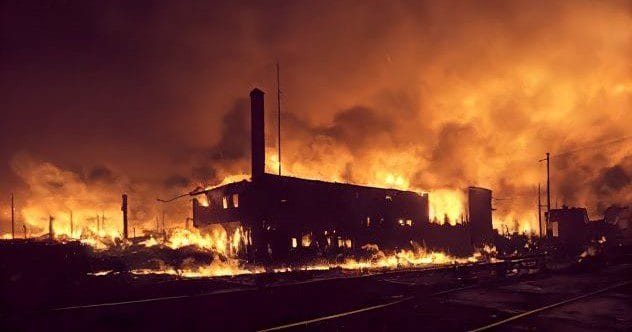We often trust that the systems around us—buildings, products, and infrastructure—are designed to keep us safe. It’s a belief so ingrained that we rarely question it. However, sometimes events occur that shatter this sense of security. These aren’t always widely publicized disasters, but rather quieter tragedies that nonetheless profoundly impact our understanding of safety.
These lesser-known incidents have revealed hidden vulnerabilities that many of us never imagined. They might not have dominated the news, but they were life-altering for those affected. The aftermath of each event exposed shocking flaws in the systems we depend on, compelling society to confront the uncomfortable truth that safety is more fragile than we like to believe.
Let’s explore ten such events that upended our assumptions about safety. These stories remind us that safety isn’t guaranteed; it’s a delicate balance requiring constant vigilance. By learning from these overlooked disasters, we can gain insights into preventing future tragedies and ensuring a safer world.
1. When a Train Defied the Station (1895)
In 1895, the Montparnasse Station in Paris witnessed a dramatic train accident. The Paris-Granville Express, running late, sped into the station. Its brakes failed, causing the locomotive to crash through the buffers, smash through the station wall, and dangle from the second floor.
Miraculously, only one person, a newspaper vendor, died from falling debris. Passengers sustained minor injuries, but the image of the train hanging from the station left a lasting impression. Iconic photographs highlighted the vulnerability of even solid structures when safety fails.
The accident exposed railway safety flaws, leading to braking system and regulation changes. The Montparnasse crash reminds us that even trusted systems can fail, shaking our confidence in assumed safety. [1]
2. The Day Safety Was Locked Away (1991)
In 1991, a fire at the Imperial Food Products plant in Hamlet, North Carolina, revealed deadly consequences of prioritizing profits over safety. A faulty fryer sparked the fire, and workers found exit doors locked, a decision costing 25 lives.
Management had padlocked the exits to prevent theft and deter union organizers. The plant had never been inspected, and local officials overlooked dangerous conditions for the sake of jobs. The fire exposed how the pursuit of “cheap” compromised worker safety.
Though the Hamlet fire led to changes, it faded from the spotlight, reminding us of the risks when safety is sacrificed. It forced a rethink of the real cost of “cheap” labor. [2]
3. The Day a River Turned Toxic (2005)
In November 2005, an explosion at a petrochemical plant in Jilin, China, caused a toxic disaster. Chemicals spilled into the Songhua River, a vital water source for millions. The contamination forced Harbin to shut off its water supply for days.
The toxic plume stretched over 93 miles, crossing into Russia and causing international tension. Despite dilution efforts, chemical levels remained high, causing health fears. The spill exposed the vulnerability of essential resources like water to industrial accidents.
This disaster was a stark reminder of how easily vital resources can be compromised, forcing a reconsideration of industrial progress costs and the importance of safety. [3]
4. Poison in a Bottle (2022)
In 2022, The Gambia faced a tragedy where nearly 70 children died after taking cough syrup that was found to contain toxic chemicals like diethylene glycol and ethylene glycol. These substances caused acute kidney failure in the young victims.
The syrups came from Maiden Pharmaceuticals in India, a company with a troubling track record. Despite warnings, the company continued exporting products, with The Gambia being a victim. Local authorities didn’t test the syrups, trusting they met safety standards.
This disaster highlighted that we can’t take medicine safety, especially in low-income countries, for granted. It showed that even basic safeguards can fail with devastating consequences. [4]
5. A Halloween Night Turned Tragic (1963)
On Halloween night in 1963, at the Indiana State Fairgrounds Coliseum, a propane gas leak ignited, causing a massive explosion during an ice show. Seventy-four people died, and nearly 400 were injured.
The explosion exposed the deadly consequences of neglecting safety standards in public spaces. Concrete debris rained down, and the arena became a somber scene as rescuers helped the injured and identified the dead.
This tragedy forced a reconsideration of public venue safety and highlighted the risks of cutting corners when protecting lives. [5]
6. The Fiery Wake-Up Call in Cleveland (1944)
On October 20, 1944, Cleveland was rocked by an explosion at the East Ohio Gas Company from leaking liquid natural gas. The explosion caused a fire that destroyed homes, businesses, and vehicles and killed 130 people.
Gas seeped into sewers, causing additional explosions. The disaster exposed flaws in industrial safety, forcing a reevaluation of how dangerous substances were handled and stored.
The East Ohio Gas explosion reminds us how quickly things can go wrong and the importance of never taking safety for granted. [6]
7. The Day a School Became a Deathtrap (1908)
On March 4, 1908, a fire at Lakeview Elementary in Collinwood, Ohio, killed 172 children and two teachers. Blocked exits and narrow stairways turned the school into a deadly trap.
The Collinwood School Fire was a wake-up call that forced the country to confront flaws in school safety standards. It led to changes in building codes and fire safety regulations.
This horrific event highlights the importance of vigilance in ensuring the safety of our children. [7]
8. The Secret Tragedy at Baikonur (1960)
On October 24, 1960, at the Baikonur Cosmodrome, an accident occurred during the testing of the R-16 intercontinental ballistic missile. A premature ignition caused an explosion, killing 92 people.
The Soviet government covered up the disaster for nearly 30 years. The Nedelin disaster was a reminder of the consequences of neglecting safety for technological progress.
The secrecy surrounding the event added to its dark legacy, showing how far some will go to hide failures. [8]
9. When a Village’s Worst Fears Came True (1966)
On October 21, 1966, the village of Aberfan, Wales, faced a tragedy when a coal waste tip collapsed, engulfing Pantglas Junior School. One hundred sixteen children and 28 adults died.
Warnings about the coal tip had been ignored. The disaster struck at the heart of Aberfan, highlighting what happens when safety is sacrificed for convenience.
The Aberfan disaster forced a reckoning with failures and underscored the importance of listening to community concerns. [9]
10. The Dam That Couldn’t Hold Back Disaster (1975)
In August 1975, the Banqiao Dam in China failed due to Typhoon Nina, causing a flood that killed approximately 171,000 people. The town of Daowencheng was completely destroyed.
The Banqiao Dam failure forced China to confront vulnerabilities in its infrastructure and rethink flood control approaches.
This disaster proved that even advanced engineering has limits and that nature’s force can have catastrophic consequences. [10]
These ten lesser-known historical events significantly reshaped our understanding of safety. From train accidents to toxic spills and dam failures, each tragedy exposed critical vulnerabilities in the systems we rely on. By learning from these overlooked disasters, we can work towards preventing future incidents and creating a safer world for everyone.
Share your thoughts about these events in the comments below. What safety measures do you think are most crucial in today’s world?










